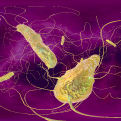
Dr_Microbe / iStock
A meta-analysis of studies examining testing algorithms for Clostridioides difficile infection (CDI) recommended nucleic amplification tests (NAAT) as a best practice in three key clinical scenarios, either alone or in combination with other testing modalities, for identifying the C. difficile organism or toxin.
The panel of 24 authors from U.S. and Australian institutions writing in Clinical Microbiology Reviews recommended:
- NAAT alone for detecting the C. difficile toxin gene;
- Glutamate dehydrogenase (GDH)/NAAT algorithm for detecting the C. difficile organism/toxin gene; and
- GDH/toxin/NAAT algorithm for detecting the C. difficile organism, toxin, or toxin gene.
Due to insufficient evidence, the researchers recommended neither for nor against repeated NAAT testing within 7 days after a negative result.
The paper’s first author stressed in comments to CLN Stat that clinical labs need to be aware of whether clinicians are testing the right people with sensitive tests. “Laboratories should definitely reject formed stool, and from those people on laxatives, and they need to interface as much as possible with clinicians to take a good diarrhea history and test people with the right clinical syndrome,” said Colleen Kraft, MD, MSc, co-director of the Emory University School of Medicine Antibiotic Resistance Center and medical director of the microbiology section at Emory Medical Laboratories in Atlanta.
Known for high rates of morbidity and mortality, CDI accounts for up to 25% of all diarrhea-associated cases in healthcare settings. For patients presenting with diarrhea, the potential to over- and underdiagnose this condition is high. “Accurate diagnosis of CDI is critical for appropriate patient management and reduction of harms that may arise from diagnostic error and is critical for implementation of infection control measures to prevent transmission,” the investigators emphasized.
A variety of tests support diagnosis in conjunction with clinical symptoms. These include:
- NAAT (polymerase chain reaction/PCR or loop-mediated or helicase-dependent isothermal amplification);
- Toxigenic culture (TC);
- Cell cytotoxicity neutralization assay (CCNA); and
- Enzyme immunoassays (EIAs) and immunochromatographic assays to detect GDH, toxin A or B, or both toxins.
Best practices to diagnose CDI remain problematic, however. “Current laboratory practice is not standardized, with wide variation in test methods and diagnostic algorithms,” the authors noted.
Each test has particular challenges and limitations. TC and CCNA remain the reference methods for diagnosing CDI, but both are slow and labor-intensive, according to the authors. Meanwhile, diagnostic accuracy measures of NAAT like sensitivity and specificity and positive predictive value (PPV) and negative predictive value (NPV) may not directly link with the clinical definition of CDI. In addition, PPV and NPV are dependent on disease prevalence in the patient population being tested, according to the authors. “So, unless we are ensuring the right preanalytical criteria, we are overdiagnosing this syndrome and causing unnecessary treatments,” Kraft said.
With so many existing varieties of tests and algorithms, labs have failed to reach consensus on what best practices should be used, specifically with regard to NAAT. Should this test be used alone or in combination with other tests such as GDH?
Investigators decided to focus their analysis on this question, conducting a systematic review to see which testing methods in conjunction with NAAT yielded the most accurate results for diagnosing CDI. Evaluating more than 11,000 records from electronic databases, 72 studies yielded enough data for meta-analysis. Specifically, the investigators assessed the diagnostic accuracy of NAAT tests alone in addition to algorithmic testing (NAAT plus GDH or toxin EIA). “Our main finding was that we could really only look at an intermediate outcome and not the actual clinical outcome. The reason for this is the large majority of articles on diagnostic testing do not take into account the preanalytical aspects (such as formed stool), nor do they look at outcome measures,” Kraft said.
Next steps are to look at the utility of clinical outcome reporting to determine accuracy in diagnostic tests. “We found in this systematic review that most of the studies we looked at did not have preanalytic and clinical outcomes data. Our hope is that future studies will consider those aspects in order to determine the utility of these tests in patient diagnosis and patient care,” said Kraft in a statement.